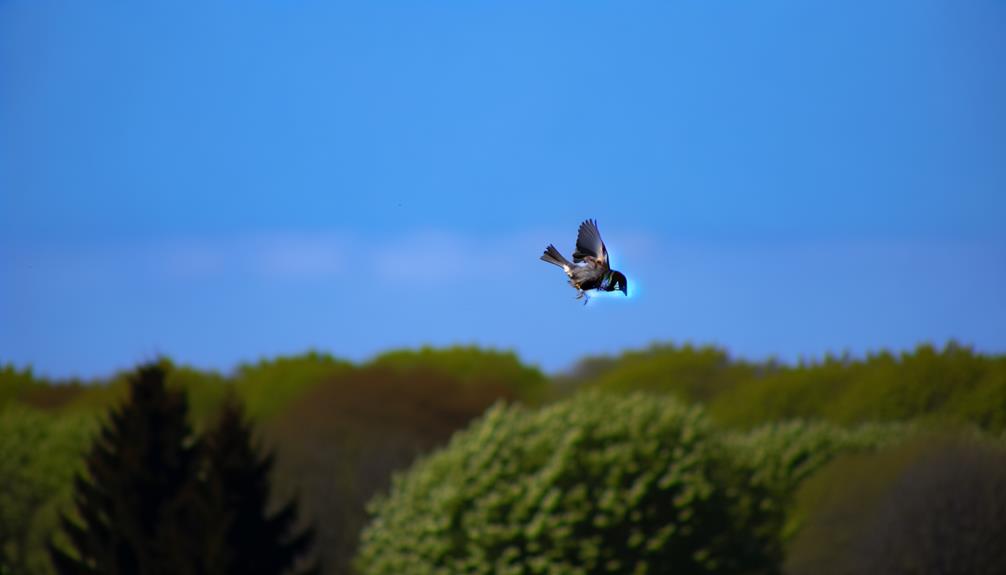How to Help a Sparrow Fly Without Tail Feathers
A sparrow can indeed fly without its tail feathers, but this comes with significant drawbacks. Tail feathers are essential for stability, maneuverability, and precise control during flight.
Without them, a sparrow experiences increased drag, reduced lift, and compromised balance. This makes sharp turns and stops challenging and energy expenditure higher.
Field studies indicate that sparrows with missing tail feathers exhibit altered flight patterns and reduced aerial agility. They adapt by altering flight behavior and increasing reliance on ground locomotion.
Understanding how these birds cope without tail feathers sheds light on their remarkable adaptability and resilience.

Key Takeaways
- Sparrows can fly without tail feathers but experience significantly reduced stability and control.
- Missing tail feathers increase drag and reduce lift, complicating flight mechanics for sparrows.
- Flight efficiency and sharp maneuverability are compromised in sparrows lacking tail feathers.
- Sparrows adapt by increasing wing flapping frequency and relying more on ground movement.
- They prioritize regrowing tail feathers to return to optimal flight performance swiftly.
Importance of Tail Feathers

Tail feathers, or rectrices, play a vital role in avian flight dynamics by providing stability, maneuverability, and control. These specialized feathers act as aerodynamic surfaces that assist in fine-tuning flight trajectories.
By adjusting the orientation and spread of their tail feathers, birds can execute intricate aerial maneuvers, such as banking, diving, and braking. The rectrices also contribute to maintaining equilibrium during flight, counterbalancing the forces generated by wing flapping.
Essentially, tail feathers function similarly to the rudder and elevator on an aircraft, enabling precise directional changes and altitude adjustments. Without these critical structures, birds would face significant challenges in maintaining flight efficiency and agility, ultimately compromising their ability to navigate and survive in their natural habitats.
Anatomy of a Sparrow's Tail
Understanding the specific anatomical structure of a sparrow's tail provides deeper insights into how these feathers contribute to flight dynamics and overall avian physiology.
The tail consists of 12 rectrices, or tail feathers, which are symmetrically arranged around the pygostyle, a bony structure at the end of the vertebral column. These feathers are supported by a complex arrangement of muscles and tendons, allowing for precise control during flight.
The rectrices are essential for maneuverability, braking, and balance. Additionally, the tail features a network of blood vessels and nerves, ensuring that the feathers receive the necessary nutrients and sensory input.
This intricate anatomy underscores the tail's crucial role in a sparrow's ability to navigate its environment effectively.
Flight Mechanics Without Tail Feathers

The absence of tail feathers significantly hampers a sparrow's flight mechanics, impacting its aerodynamics, maneuverability, and overall stability in the air.
Tail feathers play a vital role in maintaining balance and facilitating precise control during flight. Without them, a sparrow experiences increased drag and reduced lift, making it challenging to achieve efficient and sustainable flight.
The bird's ability to execute sharp turns and sudden stops is severely compromised, as tail feathers act as a rudder, contributing to directional control.
Additionally, the lack of tail feathers hinders the sparrow's capacity to stabilize itself during turbulence and gusts of wind, posing significant challenges to its navigation and survival.
Case Studies and Observations
Numerous field studies and controlled experiments have been conducted to assess the impact of tail feather loss on sparrow flight dynamics. These studies provide valuable insights into the adaptive behaviors and physiological responses of sparrows. Observations indicate that sparrows with missing tail feathers exhibit altered flight patterns, including reduced stability and control during maneuvers.
In controlled environments, researchers have documented increased energy expenditure in such sparrows. This is evidenced by elevated heart rates and metabolic rates. Behavioral adaptations, such as increased reliance on wing adjustments for balance, were also noted.
Additionally, field observations highlight that these sparrows tend to minimize time spent in flight, opting for shorter, more strategic movements. These findings collectively underscore the significant role tail feathers play in avian flight efficiency and stability.
Adaptation and Survival Strategies

Sparrows that lose their tail feathers employ a range of adaptation and survival strategies to mitigate the adverse effects on their flight capabilities and overall fitness. One primary strategy involves modifying their flight behavior to compensate for the loss of stability and maneuverability. For instance, these birds may increase wing flapping frequency and amplitude to maintain altitude and control. Additionally, sparrows enhance their foraging efficiency by selecting food sources that require less aerial agility.
They may also increase their reliance on ground-based locomotion and shelter in denser foliage to avoid predators. Physiologically, the regrowth of tail feathers is prioritized, ensuring a swift return to best flight performance. These adaptive behaviors underscore the resilience and versatility of sparrows in response to feather loss.
Conclusion
The absence of tail feathers in a sparrow intricately disrupts its aerodynamic equilibrium, akin to a sailboat steering without a rudder. Such a deficiency impairs flight stability and maneuverability, leaving the bird vulnerable to predators and environmental challenges.
However, nature's resilience offers a glimmer of hope; sparrows may develop compensatory behaviors to mitigate these limitations. Consequently, the dance between anatomical necessity and adaptive ingenuity underscores the fragile balance within avian survival strategies.






